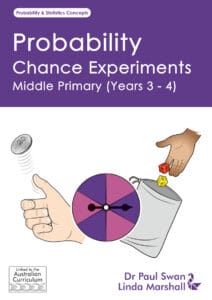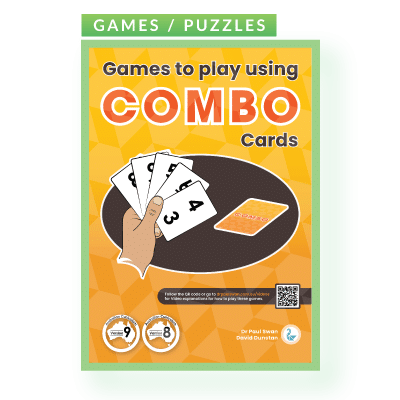AC9M3P01
Probability > Language of Probability
Australian Curriculum Version 9 Says:
Identify practical activities and everyday events involving chance; describe possible outcomes and events as ‘likely’ or ‘unlikely’ and identify some events as ‘certain’ or ‘impossible’ explaining reasoning.
What this means
Conducting simple chance experiments to develop probability language. Students make a choice out of a pair. Ordering probabilties is in Year 4.
- Year 3 is the first time students encounter Probability.
- Practical activities; roll dice, flick spinners and pull items out of a bag to develop a feeling for chance. While this is happening, students are introduced to the language of chance. Students can then use this language to make predictions about potential outcomes.
Language Examples:
- certain /uncertain
- always / never
- likely / unlikely
- a chance / no chance
- possible / impossible
Interactives & Downloadables
Resources & Manipulatives
-
10-Sided Polyhedral Dice (100pc)
$69.00 inc. GST -
6-Sided Dot Dice - Assorted Colours (100pc)
$55.00 inc. GST -
Jumbo Dice Classroom Set (24pc)
$40.00 inc. GST -
Assorted Classroom Dice Set (60pc)
$33.00 inc. GST -

- Select options This product has multiple variants. The options may be chosen on the product page
Probability Chance Experiments - Middle Primary
$22.00 – $129.00 inc. GST -
Pocket Dice (Single)
$17.50 inc. GST -
Suction Spinner (10 pack)
$15.00 inc. GST -
Spinners: Round Transparent Spinners (5 Pack)
$15.00 inc. GST -
Plastic Spinner Arrows (40)
$15.00 inc. GST -
Take Sum Risks
$13.50 inc. GST
Beyond
Quick Guides (AC9) Purpose
These Quick Curriculum Guides have been designed to take a look at the new Australian Mathematics Curriculum (AC9), explain terminology and provide interpretations. The Notes version (downloadable) has one card per page with some lines for your own personal notes
Year 7+?
Our Quick Guides end at Year 6, but if you look at the bottom of the Year 6 cards you will see that they are linked onwards to Year 7. We recommend you visit the appropriate Curriculum pages on ACARA’s site.
Disclaimer
These documents serve as general advice only and do not take into account your specific needs and conditions. While best care has been taken in compiling these materials, mistakes may exist. Australian Curriculum version 9 materials used under Creative Commons licence from ACARA. Readers should always refer back to the curriculum itself and the state-based curriculum that is relevant for you. These documents copyright of A-Z Type (Dr Paul Swan). Copies may be downloaded
These Quick Curriculum Guides have been designed to take a look at the Australian Mathematics Curriculum (AC9), explain terminology and provide interpretations.
Narelle and I have used our professional judgement to put forward what is appropriate for students at this year level.
Authors: Dr Paul Swan & Narelle Rice
We would like to also thank Linda Marshall and David Dunstan for comments and assistance.
These documents serve as general advice only and do not take into account your specific needs and conditions. While best care has been taken in compiling these materials, mistakes may exist.
Australian Curriculum version 9 materials used under Creative Commons licence from ACARA. Readers should always refer back to the curriculum itself and the state-based curriculum that is relevant for you.
This document is copyright of A-Z Type (Dr Paul Swan). A copy of this document may be downloaded from www.drpaulswan.com.au.












